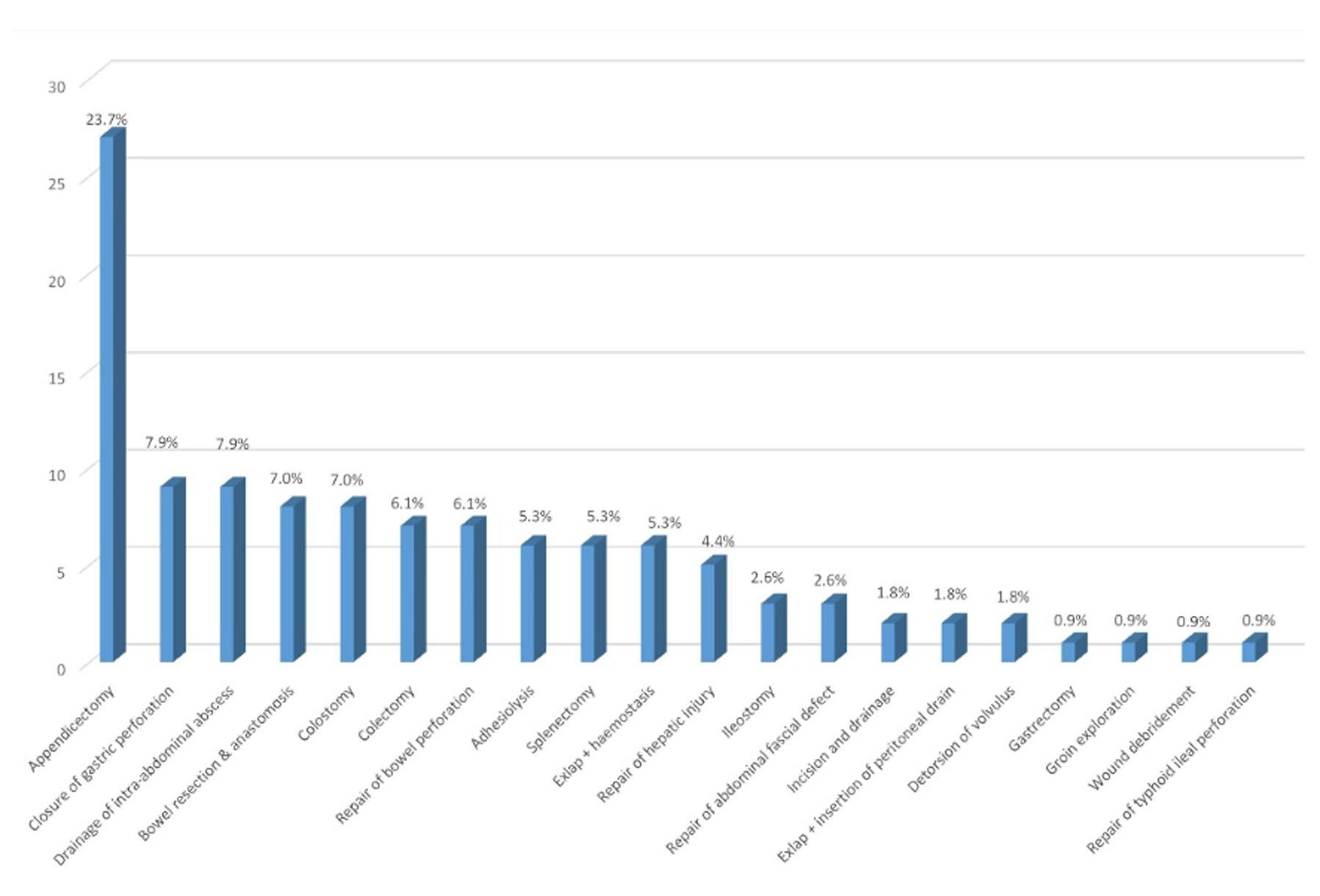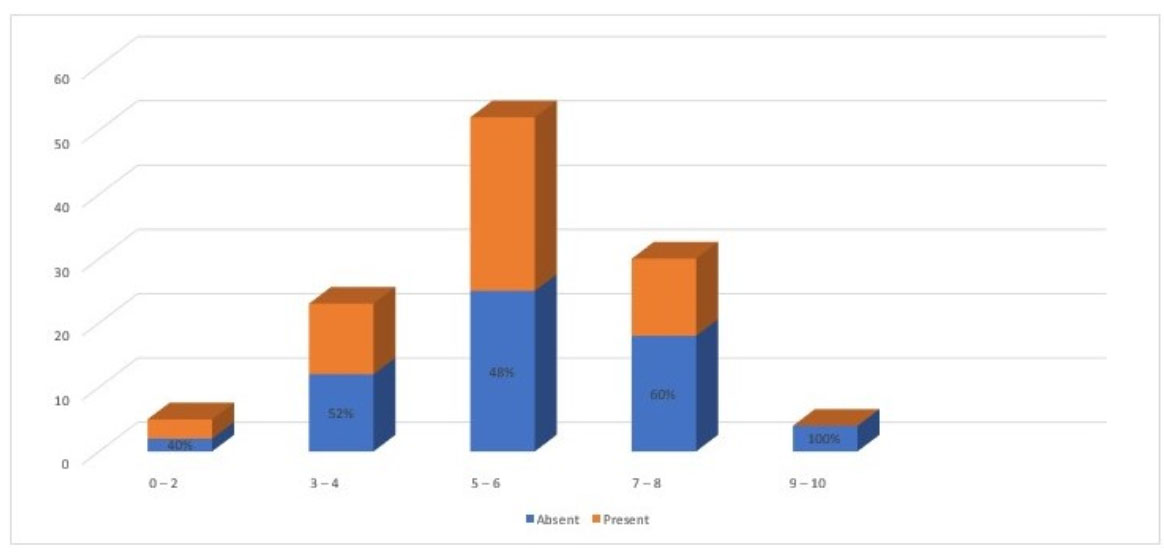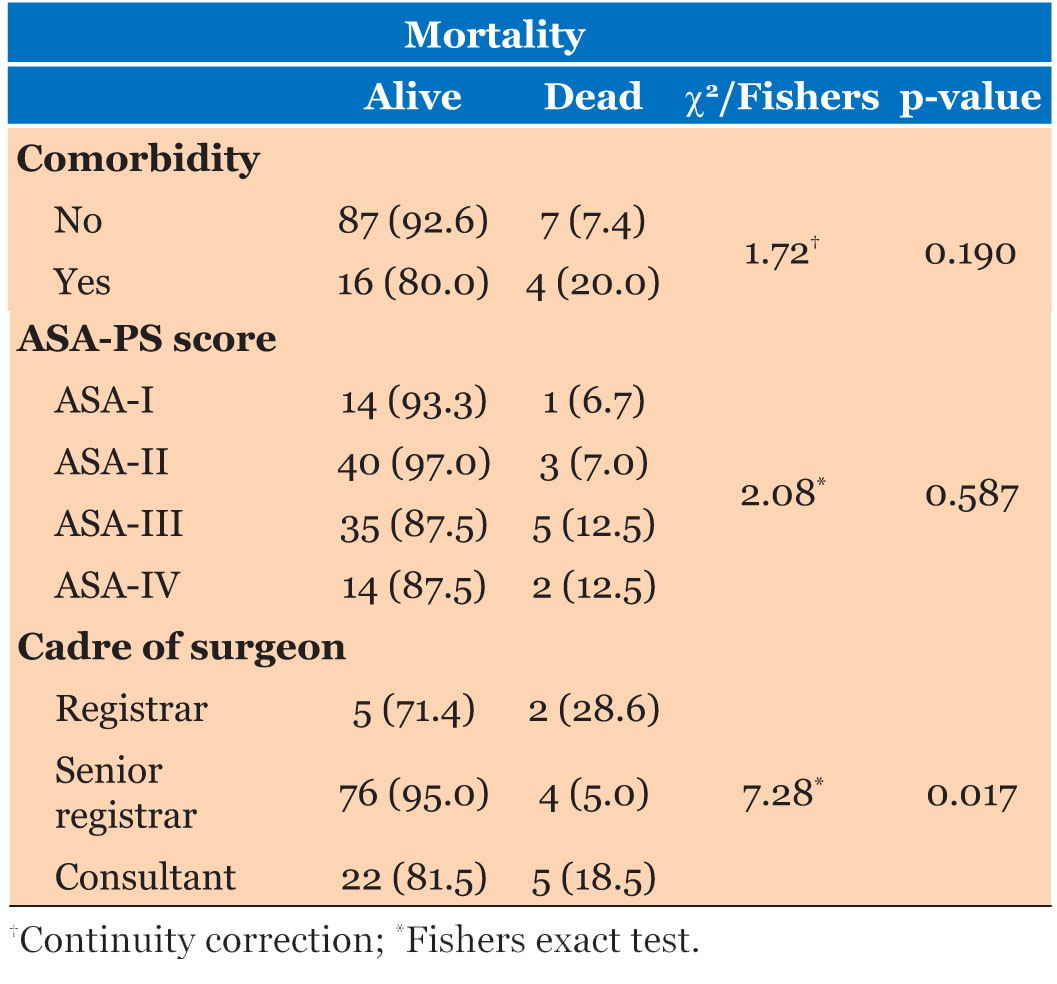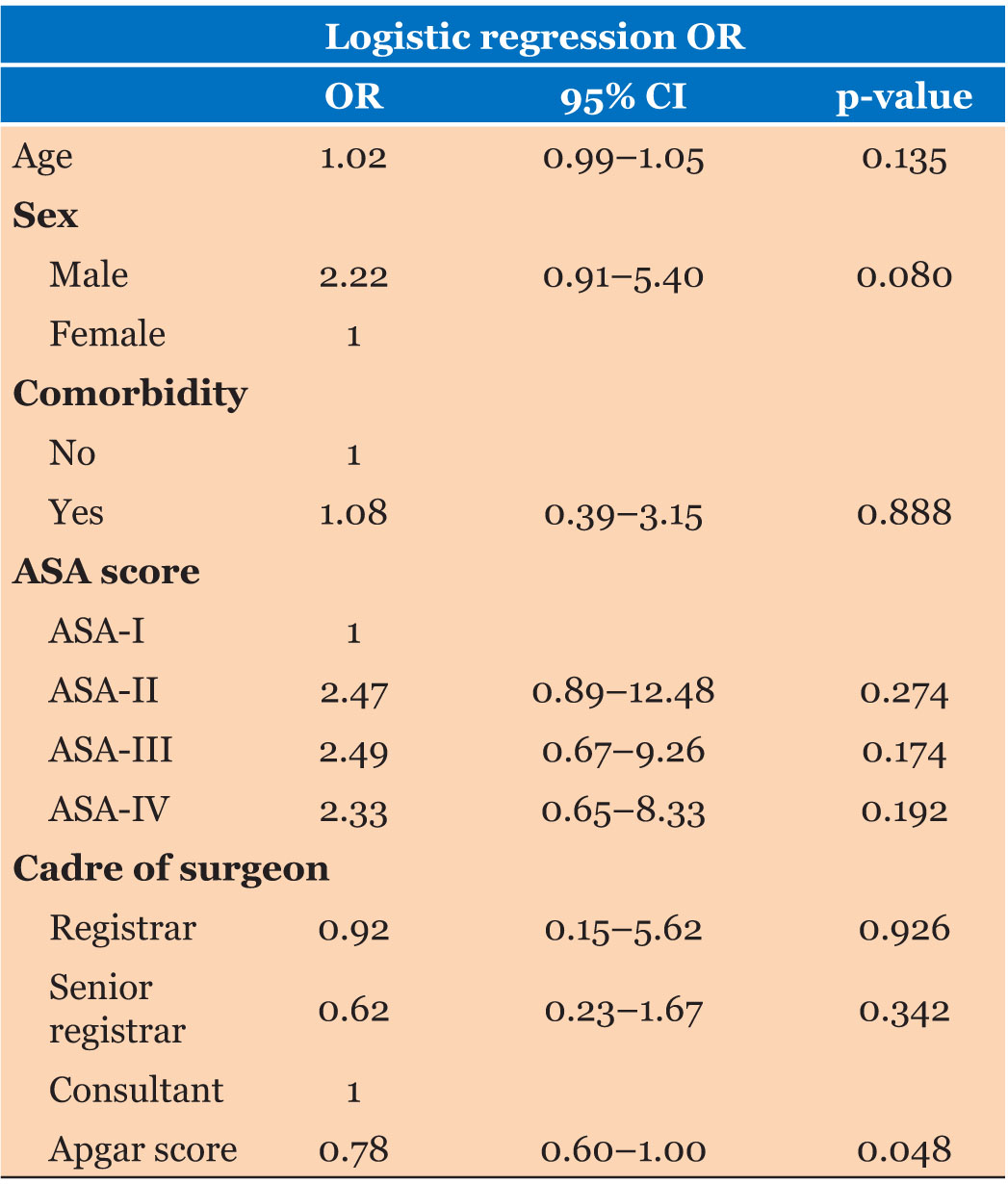 |
Research Article
Evaluation of surgical Apgar score as a predictor of post-operative complications in emergency general surgical patients in a Nigerian teaching hospital
1 Consultant General Surgeon, Division of Gastrointestinal Surgery, Department of Surgery, College of Medicine, University of Ibadan/University College Hospital, Ibadan, Oyo State, Nigeria
2 Senior registrar in General Surgery, Department of Surgery, University College Hospital, Ibadan, Oyo State, Nigeria
Address correspondence to:
Ikechukwu Bartholomew Ulasi
Department of Surgery, University College Hospital, PMB 5116, Ibadan, Oyo State,
Nigeria
Message to Corresponding Author
Article ID: 100057S05OA2022
Access full text article on other devices

Access PDF of article on other devices

How to cite this article
Afuwape O, Ulasi IB. Evaluation of surgical Apgar score as a predictor of post-operative complications in emergency general surgical patients in a Nigerian teaching hospital. Edorium J Surg 2022;9:100057S05OA2022.ABSTRACT
Aims: The aim of this study was to evaluate the ability of the surgical Apgar score (SAS) to predict post-operative complications at the University College Hospital (UCH), Ibadan, Nigeria.
Methods: This was a retrospective study of adult patients undergoing emergency general surgery procedures. The main end-points were post-operative mortality and surgical site infection (SSI). The ability of the SAS to predict post-operative outcomes was determined using the receiver operating characteristics curve (ROC). Statistical significance was defined by a p value of <0.05.
Results: The mean SAS was 5.6 ± 1.7 with majority of patients (61.4%, n = 70) being at medium risk (Apgar score 5–7) for post-operative complication. The most common post-operative complication was SSI (47.1%, n = 25) with a 30-day mortality of 9.6%. The ROC curve showed that the SAS is a poor predictor of post-operative complications (Area under the curve [AUC] = 0.408) and mortality (AUC = 0.394). However, there is a statistically significant association between mean SAS and occurrence of post-operative complications (p = 0.026).
Conclusion: The SAS does not predict post-operative complications in adult patients undergoing emergency general surgery procedures.
Keywords: Post-operative complications, Predictor, Surgical Apgar score
INTRODUCTION
Post-operative mortality is the third commonest cause of global death (after ischemic heart disease and stroke) half of which are in low- and middle-income countries (LMICs) [1]. Although delayed and suboptimal surgical care have been implicated as contributory to post-operative mortality in LMICs [2], non-adherence to peri-operative best practices also plays a key role [3]. Peri-operative surgical risk assessment (a key peri-operative best practice) not only helps in planning patient care in the peri-operative period but also reduces mortality by reserving more intensive post-operative intervention to patients in utmost need based on their risk stratification.
Anesthetists and surgeons often anticipate the peri-operative events involved in major surgeries based on factors such as age, associated co-morbidities, and severity of the disease conditions. The most used risk assessment scale in our environment is the American Society of Anaesthesiologist Physical Status (ASA-PS) grading which measures risk based on pre-operative variables. This 6-scale system (introduced in 1941 with latest revision in 2014) assesses the risk of a patient undergoing any procedure requiring anesthesia based on the patient’s underlying systemic illness. Although increasing ASA-PS grade has been shown to correlate well with increasing risk of post-operative mortality [4], it is not intended to predict risk. In addition, ASA-PS does not consider intra-operative factors.
Surgical risk scoring plays a role in predicting post-operative outcomes. This enables surgical teams to prognosticate patients’ post-operative conditions and plan for specific interventions post-operatively such as intensive care unit (ICU) admission. Secondly, units which are not fully equipped with multispecialty areas could plan transfer of patients to a more specialized facilities based on the risk score.
While some risk assessment systems [like Surgical Risk Scale (SRS), the Goldman Cardiac Risk Index (CRI), Glasgow Coma Scale (GCS) scores, Surgical Outcome risk Tool (SORT), Karnofsky Performance Score (KPS), Charlson Comorbidity Index and Trauma Injury Severity Scores (TISS)] use pre-operative variables, others [like the Acute Physiology and Chronic Health Evaluation (APACHE), Simplified Acute Physiology Score (SAPS), Portsmouth-Physiological and Operative Severity Score for the enUmeration of Mortality and Morbidity (P-POSSUM) score incorporate variable components of pre-, intra-, and post-operative data] [5],[6],[7]. Although each individual risk assessment system has its benefits and limitations, the less complex systems are preferable in clinical practice [8].
The surgical Apgar score (SAS) described by Gawande et al. in 2007 was derived from a retrospective analysis of 303 patients who underwent colectomy at Brigham and Women’s Hospital, Boston [9]. A 10-point score based on the estimated blood loss (EBL), the lowest intraoperative heart rate, and lowest recorded mean arterial pressure (Table 1), the SAS has been used to accurately predict early and 30-day post-operative complications in all major surgeries in the last decade. Higher scores were associated with better outcomes at the end of 30 days.
SAS is unique in the fact that it utilizes only intra-operative data made up of three variables, making it less cumbersome and in keeping with the maxim that an ideal risk assessment scoring system should contain few variables. Originally applied to general and vascular surgical procedures [9], the SAS has found its use in other fields of surgery today. It is therefore pertinent to investigate the applicability of a simple outcome predictor among surgical patients in a low resource environment with poor outcome indices.
This study evaluates the ability of SAS to predict post-operative complications in adult patients undergoing emergency general surgery procedures in a tertiary hospital in southwest Nigeria.
MATERIALS AND METHODS
This was a retrospective study involving a cohort of consecutive adult patients, aged 18 years and above, undergoing emergency general surgery procedures in the Department of Surgery, UCH, Ibadan between 1st October 2018 and 30th September 2019. Ethical approval was obtained from the joint University of Ibadan/UCH Ethical Review Committee (UI/EC/20/0274).
Data obtained included socio-demographic variables like age, gender, source of referral, presenting complaint, diagnosis, comorbidities, ASA-PS grade and time from presentation to surgery. Intra-operative data obtained included duration of surgery, the procedure performed, cadre of surgeon, estimated blood loss (EBL), lowest intra-operative heart rate recorded, lowest mean arterial pressure recorded, and need for intra-operative ionotropic support. The SAS was calculated from the recorded lowest intra-operative heart rate, lowest mean arterial pressure, and the EBL. Recorded post-operatively were location of post-operative care, need for repeat surgery, need for re-intubation or mechanical ventilation, post-operative complications, and outcome as at the 30th day post-operatively.
The end points are post-operative mortality, defined as death occurring up to 30 days after surgery; SSI defined based on the United States Centre for Disease Control and Prevention criteria for defining SSI [10], and other post-operative complications. Patients were categorized as high risk (SAS < 5), medium-risk (SAS 5–7) or low-risk (SAS 8–10) based on their APGAR scores. Emergency general surgical procedure was defined in this study as any life-saving procedure within the realm of general surgery that was performed within 24 hours of the patient’s presentation [11]. All the procedures were through an open approach.
The ability of the SAS to predict post-operative outcomes was determined using the ROC curve. Chi-square and Fisher’s exact tests were used to determine the association between SAS category and post-operative outcomes, and to determine if there was an association between some pre-operative variables (like comorbidity, ASA-PS score, cadre of surgeon) and post-operative outcome. The student t-test was used to determine association between mean Apgar score and post-operative outcomes. Statistical package for the Social Sciences software, version 25 was used to analyze the data and statistical significance was defined by a p value of <0.05.
RESULTS
In this study, 114 patients were included with age range of 16–86 years (mean age, 42 ± 16 years). There was male predominance noted with a male-to-female ratio of 2:1. Most of the patients were in the 4th decade of life (Table 2).
The commonest presenting complaints were abdominal pain (34.2%, n = 39) and abdominal swelling (16.7%, n = 19) with majority of patients (48.2%, n = 55) having only one presenting complaint. The median duration of symptoms was three days (IQR = 1424). The most common diagnoses were acute appendicitis (23.7%, n = 27), abdominal injury (20.2%, n = 23), and intestinal obstruction (11.4%, n = 13). Only 22.8% of the diagnoses were trauma-related, out of which 77% involved one organ-system while the rest involved two or more organ-systems.
The most frequently performed surgical procedure was appendectomy (23.7%, n = 27) (Figure 1). The comorbidity status, cadre of the operating surgeon and the incidence of adverse events such as the need for inotropes, delayed recovery from anesthesia (which were minimal) are as shown in Table 3. The mean SAS was 5.6 ± 1.7 with majority of patients (61.4%, n = 70) being at medium risk of post-operative complication. A 30-day mortality of 9.6% was recorded. Less than half of the patients (46.5%, n = 53) recorded post-operative complications. The distribution of post-operative complications (Figure 2) shows incisional surgical site infection (37.7%, n = 20), followed by post-operative mortality (17.0%, n = 9) and organ-space surgical site infection (9.4%, n = 4) as the most frequent morbidities.
The ROC curves on the predictive power of SAS for post-operative complications and mortality (Figure 3 and Figure 4) showed an AUC of 0.408 and 0.394 respectively indicating a poor predictive power for post-operative complications and mortality. The cut-off Apgar score below which post-operative complication and mortality could be predicted was 5.5 (specificity and sensitivity of 41.5% and 44.3% vs 36.4% and 49.5% respectively). Although patients with SAS of < 5 are thrice at risk of post-operative death and 4 times at risk of post-operative complications than those with a score category of 8–10, there is no statistically significant association between SAS category and post-operative outcomes. However, there is a statistically significant difference in the mean Apgar score between those who had post-operative complications (5.93 ± 1.73) and those who had no complications (5.22 ± 1.59) (p = 0.026) as shown in Table 4. Similarly, there is consistent reduction in the proportion of patients who had complications with increasing range of SAS (Figure 5). Patients admitted to the ICU had a statistically significant lower mean Apgar score compared with those nursed only in the recovery room (3.50 ± 1.91 vs 5.63 ± 1.67; p = 0.014). Neither the mean Apgar score nor the Apgar score categories predicted post-operative mortality. Result from a prohibit model shows a 74% chance of post-operative complication at an Apgar score of 1 (p ≤0.001; CI = 0.49–1.00) compared to 24% at a score of 10 (p = 0.022; CI = 0.04–0.45; CI = −0.07 to 0.58) and a 25% chance of death at a score of 1(p = 0.126; CI = −0.04 to 0.10) compared to 3% at 10. The comorbid status, ASA-PS grade of patient and cadre of surgeon were not found to be significantly associated with occurrence of post-operative complications. The cadre of surgeon however had a statistically significant association with post-operative mortality (p = 0.017) with the odds of post-operative mortality being significantly less among senior registrars (OR = 0.07; CI = 0.01–071; p = 0.024) as shown in Table 5. There was no statistically significant association between the post-operative mortality and the comorbid status or the ASA-PS grade of patient. However, highest mortality rate (12.5%, n = 5) was recorded within the ASA grade III category. A subgroup analysis of patients in the ASA grade III category for difference in mortality across the cadre of surgeons showed a statistically significant difference with most of the mortality (60%; n = 5) occurring in the consultant category (p = 0.004). As shown in Table 6, the mean surgical Apgar score has a statistically significant inverse relationship with post-operative complication (p = 0.048). There was no statistically significant association between patient’s age or gender and post-operative complications or mortality.
DISCUSSION
The ability to predict the occurrence of post-operative complications enables adequate planning for the use of high dependency or intensive care bed spaces which are often limited in lower middle-income countries (LMIC). In LMICs, increased post-operative mortality and morbidity compared to more developed countries [12] makes the need for risk prediction more compelling. Previous studies have shown the SAS as a simple risk prediction model effective in predicting post-operative outcomes. In this study, although a significant association was demonstrated between mean SAS and occurrence of post-operative complications, the SAS was found to be a poor predictor of post-operative complications.
We recorded a male preponderance of patients most of whom are in their 4th decade of life, similar to findings from previous multi-center and local studies [12],[13] on emergency general surgical procedures. Majority of the patients were referred from other health facilities in contrast to previous reports that 60–90% of patients in Nigeria bypass the primary healthcare facilities to self-refer to the tertiary facilities [14].
In the cohort of emergency general surgical patients studied, acute appendicitis was the most common diagnosis similar to a previous study in Nigeria [15], and Malaysia [16], all of which were in tertiary hospitals. However, in a study in Rwanda, soft tissue infections were reported as the most common diagnosis in emergency general surgery [17]. Consequently, the commonest emergency surgical procedure in this study was appendectomy, similar to previous studies in many centers in Nigeria, East Africa, and developed countries [18],[19],[20].
Over 98% of our emergency procedures were abdominal surgical procedures with a 30-day morbidity rate of 47.1% similar to a study in Denmark [21]. However, the mortality rate of 9.6% in this study is less than 20.2% quoted in the study in Denmark. On the other hand, a similar cohort of patients undergoing emergency laparotomy in India [22] observed a 30-day mortality rate of 12% and morbidity rate of 79%. Although post-operative outcomes are worse in low-and-medium income countries, the relatively low mortality recorded in this study suggests a positive paradigm shift which requires further local studies to validate.
Majority of the patients in this study were in the medium risk group (SAS 5–7) for post-operative complications with a mean SAS of 5.6 ± 1.7. The cut-off Apgar score below which post-operative complication and mortality could be predicted was 5.5. In a study on esophagectomy, the cut-off value of the SAS that predicted morbidity in patients was a score ≤6.39 [23]. The cut-off (SAS score) point of 5.5 in this study implies a higher risk of post-operative morbidity and mortality where patients with a SAS of <5 are thrice at risk of post-operative death and 4 times at risk of post-operative complications than those with a score category of 8–10. Lower SAS has been identified as an independent predictor of adverse post-operative event in surgical patients [24]. The SAS had a poor predictive power for post-operative complications and mortality in our study (AUC of 0.408 and 0.394, respectively). Although the Apgar score categories neither predicted post-operative complications nor mortality in this study, there was a statistically significant difference in the mean Apgar score between those who had post-operative complications and those who had no complications, similar to the findings of Echara et al. [22] in patients undergoing laparotomy and Yusufali et al. [25]. Similarly, this study demonstrates a statistically significant lower Apgar score in patients transferred post-operatively to the ICU compared to those nursed only in the recovery room. However, neither the mean Apgar score nor the Apgar score categories predicted post-operative mortality. Nevertheless, patients with a score of 1 have a 25% chance of mortality compared to 3% chance of mortality for those with a score of 10. Rajgopal et al. reported that the relative risk of mortality falls from 239 in patients with an Apgar score of 1–2 to 6 in those with a score of 7–8, and to 1 in those with a score of 9–10 [26].
CONCLUSION
The SAS can be used to predict post-operative complications in adult surgical patients undergoing emergency procedures. However, the predictive power for post-operative outcomes is poor.
REFERENCES
1.
Nepogodiev D, Martin J, Biccard B, Makupe A, Bhangu A; National Institute for Health Research Global Health Research Unit on Global Surgery. Global burden of post-operative death. Lancet 2019;393(10170):401. [CrossRef]
[Pubmed]

2.
Maine RG, Kajombo C, Purcell L, Gallaher JR, Reid TD, Charles AG. Effect of in-hospital delays on surgical mortality for emergency general surgery conditions at a tertiary hospital in Malawi. BJS Open 2019;3(3):367–75. [CrossRef]
[Pubmed]

3.
Delisle M, Pradarelli JC, Panda N, et al. Variation in global uptake of the Surgical Safety Checklist. Br J Surg 2020;107(2):e151–60. [CrossRef]
[Pubmed]

4.
Hopkins TJ, Raghunathan K, Barbeito A, et al. Association between ASA physical status and post-operative mortality at 48 h: A contemporary dataset analysis compared to a historical cohort. Perioper Med (Lond) 2016;5:29. [CrossRef]
[Pubmed]

5.
Hariharan S, Zbar A. Risk scoring in perioperative and surgical intensive care patients: A review. Curr Surg 2006;63(3):226–36. [CrossRef]
[Pubmed]

6.
Moonesinghe SR, Mythen MG, Das P, Rowan KM, Grocott MPW. Risk stratification tools for predicting morbidity and mortality in adult patients undergoing major surgery: Qualitative systematic review. Anesthesiology 2013;119(4):959–81. [CrossRef]
[Pubmed]

7.
Reponen E, Tuominen H, Korja M. Evidence for the use of preoperative risk assessment scores in elective cranial neurosurgery: A systematic review of the literature. Anesth Analg 2014;119(2):420–32.
[Pubmed]

8.
Ajitsaria P, Eissa SZ, Kerridge RK. Risk assessment. Curr Anesthesiol Rep 2018;8(1):1–8. [CrossRef]
[Pubmed]

9.
Gawande AA, Kwaan MR, Regenbogen SE, Lipsitz SA, Zinner MJ. An Apgar score for surgery. J Am Coll Surg 2007;204(2):201–8. [CrossRef]
[Pubmed]

10.
11.
Prin M, Guglielminotti J, Mtalimanja O, Li G, Charles A. Emergency-to-elective surgery ratio: A global indicator of access to surgical care. World J Surg 2018;42(7):1971–80. [CrossRef]
[Pubmed]

12.
GlobalSurg Collaborative. Mortality of emergency abdominal surgery in high-, middle-, and low-income countries. Br J Surg 2016;103(8):971–88. [CrossRef]
[Pubmed]

13.
Onyemaechi NO, Urube SU, Ekenze SO. Pattern of surgical emergencies in a Nigerian tertiary hospital. Afr Health Sci 2019;19(1):1768–77. [CrossRef]
[Pubmed]

14.
Koce F, Randhawa G, Ochieng B. Understanding healthcare self-referral in Nigeria from the service users’ perspective: A qualitative study of Niger state. BMC Health Serv Res 2019;19(1):209. [CrossRef]
[Pubmed]

15.
Nwashilli NJ, Okobia NM, Osime OC, Agbugui OJ. The pattern and outcome of surgical acute abdomen at a Nigerian tertiary hospital. Niger J Surg Sci 2017;27(2):51–6. [CrossRef]

16.
Kandasami P, Yita T, Chi XS, et al. Emergency general surgery in a public hospital in Malaysia. Med J Malaysia 2020;75(5):467–71.
[Pubmed]

17.
Mpirimbanyi C, Nyirimodoka A, Lin Y, et al. Emergency general surgery in Rwandan district hospitals: A cross-sectional study of spectrum, management, and patient outcomes. BMC Surg 2017;17(1):121. [CrossRef]
[Pubmed]

18.
Ayandipo OO, Afuwape OO, Irabor DO, Abdurrazzaaq AI, Nwafulume NA. Outcome of laparotomy for peritonitis in 302 consecutive patients in Ibadan, Nigeria. Ann Ib Postgrad Med 2016;14(1):30–4.
[Pubmed]

19.
20.
Wohlgemut JM, Ramsay G, Jansen JO. The changing face of emergency general surgery: A 20-year analysis of secular trends in demographics, diagnoses, operations, and outcomes. Ann Surg 2020;271(3):581–9.
[Pubmed]

21.
Tengberg LT, Cihoric M, Foss NB, et al. Complications after emergency laparotomy beyond the immediate post-operative period – A retrospective, observational cohort study of 1139 patients. Anaesthesia 2017;72(3):309–16. [CrossRef]
[Pubmed]

22.
Echara ML, Singh A, Sharma G. Risk-adjusted analysis of patients undergoing emergency laparotomy using POSSUM and P-POSSUM score: A prospective study. Niger J Surg 2019;25(1):45–51. [CrossRef]
[Pubmed]

23.
Li S, Zhou K, Li P, Che G. Is surgical Apgar score an effective assessment tool for the prediction of post-operative complications in patients undergoing oesophagectomy? Interact Cardiovasc Thorac Surg 2018;27(5):686–91. [CrossRef]
[Pubmed]

24.
Orberger M, Palisaar J, Roghmann F, et al. Association between the surgical Apgar score and perioperative complications after radical prostatectomy. Urol Int 2017;98(1):61–70. [CrossRef]
[Pubmed]

25.
26.
Rajgopal V, Kulkarni SV. Efficacy of the surgical Apgar score in predicting post-operative morbidity and mortality in patients undergoing laparotomy. Int J Surg 2019;6(8):2791–6. [CrossRef]

SUPPORTING INFORMATION
Author Contributions
Oludolapo Afuwape - Substantial contributions to conception and design, Revising it critically for important intellectual content, Final approval of the version to be published
Ikechukwu Bartholomew Ulasi - Acquisition of data, Analysis of data, Interpretation of data, Drafting the article, Revising it critically for important intellectual content, Final approval of the version to be published
Guaranter of SubmissionThe corresponding author is the guarantor of submission.
Source of SupportNone
Consent StatementWritten informed consent was obtained from the patient for publication of this article.
Data AvailabilityAll relevant data are within the paper and its Supporting Information files.
Conflict of InterestAuthors declare no conflict of interest.
Copyright© 2022 Oludolapo Afuwape et al. This article is distributed under the terms of Creative Commons Attribution License which permits unrestricted use, distribution and reproduction in any medium provided the original author(s) and original publisher are properly credited. Please see the copyright policy on the journal website for more information.
















